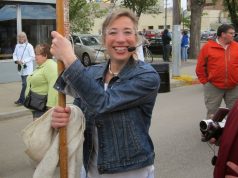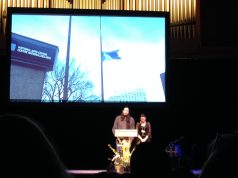The first time I flew into Calgary, after having been away for a year, I had a panic attack. On the plane. I looked out of that little porthole, and through multiple layers of Plexiglas saw the Saddledome, and Deerfoot trail and downtown, rising out of a seemingly endless sea of suburban wasteland. I was overcome with an irrational feeling of dread. What if something happened while I was visiting that would mean being stuck in the city forever. World War Three? A Zombie Apocalypse? The sudden onset of the next ice age? I would be trapped in my home city. A city I had fled at the first opportunity. My worst nightmare.
As the plane’s wheels hit the tarmac I took a deep breath and calmed myself down: World War Three would probably start in the Middle East, not Alberta. Zombies probably couldn’t make it across Saskatchewan in the winter, and a Chinook would provide respite from the ice age. In all likelihood I would be able to escape on my scheduled flight at the end of my holiday. And I did.
But things have changed since I first left Calgary for the big city lights of Toronto, then Montreal and finally London (not Ontario), where I’ve lived for the past seven years. Calgary is a different city. And I’m a different person. Now I can fly into YYC without having panic attacks. I’ve even started looking forward to the extended periods of time in Calgary and have found myself wondering what it would be like to be an artist here.
Calgary is still a fairly conservative city. Not aggressively so. It’s nothing like British conservatism, which is particularly nasty and heartless. It’s not a set of values that are explicitly enforced or imposed. Calgary is a very friendly city and by all accounts, a really nice place to live. Which is perhaps the source of its conservatism: Its niceness, its comfortable status quo. Homogeny and normality seem to be in the air and in the water here. The conditions don’t feel right here, for cutting edge, challenging work. It doesn’t have the anger, for instance, that emerged in the UK during the Thatcher or the current despair and frustration at the vast, and growing inequalities produced by the country’s grotesque love affair with neoliberal ideologies – I am, of course, grossly over generalising here to make a point. This doesn’t mean exciting, independent performance work can’t – or isn’t – happening here in this city. Indeed the recent, and accelerated growth of Calgary is giving it the sense that change is in the air.
It now has a mayor that is the envy of every city in the world, especially Toronto (sorry Toronto, I just couldn’t resist). A proliferation of new small businesses – Calgary used to have nothing but chain restaurants and coffee shops. And a population growth that means that there are more non ‘born-and-raised Calgarians’ than ever before. And perhaps most importantly, Calgarians seem to be excited by these changes and what it means for the city’s identity. But how have these changes affected potential audiences for arts in the city ? Are they developing as quickly as the city is growing? My impression is that they aren’t, and I wonder why.
For the past few years I have managed to catch a couple of shows at the High Performance Rodeo in January. I find the festival’s programming exciting and interesting, while simultaneously full of hints of how difficult it must be to program work here that pushes at established boundaries, or work that asks big, difficult questions, or even work that isn’t a ‘play’. One Yellow Rabbit has certainly helped pave the way for an alternative performance ecology here – the collective has been making alternative performance longer than I’ve been alive – and there is a growing amount of Calgary-based independent performance being made in the city.
What kind of work is missing from the landscape here? When I compare Calgary to cities in the UK of comparable size – Birmingham, Bristol, Glasgow, Liverpool, for instance – I find it lacking in the artistic diversity (please don’t hate me for using that word!) that is being produced in those cities – I must acknowledge, due to sheer size, exchange and touring is much easier in the UK and so the cultural landscapes of these cities constantly feeds each other. But, as an exercise it is interesting to think about the kind of work that is happening in those cities, which is missing from the landscape here.
Again, I’m not trying to say that alternative performance isn’t possible in Calgary – or that it isn’t happening. I’m trying to come to terms with what I think are the primary challenges for building a more diverse (argh, that word again) performance ecology here. What is the kind of work that could be in Calgary and isn’t… yet?
One aspect that I think has been crucial in helping the UK develop the rich community of artists that it has, is a collective questioning of disciplinary, artistic and aesthetic boundaries. In the UK this questioning has been usefully captured under the term ‘Live Art’, which the Live Art Development Agency describes not as ‘art form or a discipline’ but a ‘cultural strategy to include experimental processes and experiential practices that might otherwise be excluded from established curatorial, cultural and critical frameworks’. Certainly, as a young artist arriving in the UK, I found this the most exciting aspect of the cultural landscape there. I experienced a range of practices and approaches that surprised, provoked and engaged me: ‘a gene pool of artists, whose work is rooted in a broad church of disciplines, [crossing] each others’ paths, blurred each others’ edges and, in the process, opened up new creative forms’.
In Calgary I don’t perceive this happening, or at least not collectively. I see many artists and organisations staking their claim to more traditional forms and taking the disciplinary description of the work they produce as a definition of what their work is about. Perhaps this is a marketing strategy or done for fear of scaring audiences away. But marketing is not really an interesting place to make work from, and audiences often have little concern about form if what they are experiencing is engaging. What would it mean to let go of these descriptions? What would it mean to allow these descriptions to become infected by other descriptions? What would it mean to make work with a focus on an exploration of process, experience and intensity instead of holding too tightly to the form that the work will take (ie. new writing, contemporary dance, ballet). In a city whose modus operandi is homogeny and consistency, what would it mean to throw a spanner in the works of cultural production and challenge the status quo with new ideas? Is there a potential audience for this kind of work?
My impressions of Calgary have changed greatly from my first panic-ridden return almost ten years ago. It’s a city whose identity is in flux, which makes it a potentially exciting place to be an artist. Calgarians seem, more than ever, open to new experiences. I sense a strong desire to make this city a more interesting place to live, and an acknowledgment that this requires a greater focus on culture. These are ideal conditions for developing audiences. But more of the old models of making work aren’t enough to build an exciting performance ecology here. It requires more artists taking risks on new, untested models that will challenge audiences and start to put tension on some of the old habits that the city is still in the process of shaking.










